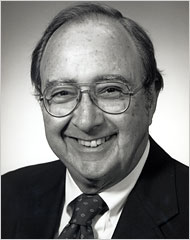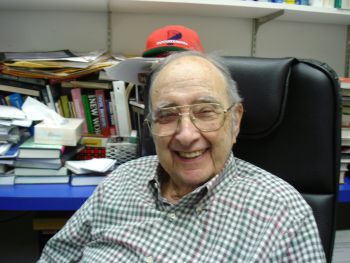
David Kritchevsky, a biochemist by training, arguably contributed as many “firsts” to the field of lipid nutrition as anyone. Some, which will be annotated below, include the first radioactive labeling of cholesterol with tritium, the production of carbon-14 labeled cholesterol by feeding labeled acetate to hens and isolating it from eggs, the first study of the metabolic fate of labeled-cholesterol following ingestion by humans, methods for separation and detection of steroids by reverse-phase paper chromatography, the first demonstration that unsaturated fat was less atherogenic than saturated fat, publication of the first books on cholesterol and β-sitosterol, the first evidence that specific fatty acids and triglyceride structure play roles in modulating serum cholesterol levels, the first finding that dietary fiber reduced serum cholesterol, and the first observation that conjugated linoleic acid feeding led to reduced atherosclerosis.
Early Career
Kritchevsky was born on January 25, 1920 in Kharkov, Russia and came to the United States in 1923. He received B.S. and M.S. degrees from the University of Chicago in 1939 and 1942, respectively, in chemistry and organic chemistry. Kritchevsky described his need to get a job as a genetic problem – his father was poor and his mother was poor – and homozygous poor meant a job rather than a higher degree! He worked as a chemist at Ninol Laboratories in Chicago from 1940 to 1946. Subsequently, he earned his Ph.D. in organic chemistry from Northwestern University in 1948. Kritchevsky obtained a postdoctoral fellowship with Leopold Ruzicka, Nobel laureate in chemistry, at the Federal Institute of Technology in Zurich, Switzerland where he became interested in the metabolism of cholesterol. Melvin Calvin, another Nobel laureate in chemistry, hired him into the Radiation Lab at the University of California, Berkeley where he worked from 1950 until 1952. He joined Lederle Laboratories in Pearl River, NY and subsequently the Wistar Institute in 1957, where he remained for the remainder of his career. He held many positions of increasing seniority, including Associate Director, and was Institute Professor and Caspar Wistar Scholar at the time of his death.
Kritchevsky also held many positions at the University of Pennsylvania in addition to his position at Wistar. He was Professor of Biochemistry in the School of Veterinary Medicine, Professor of Biochemistry in Surgery in the School of Medicine and a member of the Graduate Group in Biochemistry in the Graduate School of Arts and Sciences, which he chaired for 12 years. Medical and dental students at Penn got to learn the Krebs cycle to the tune of “Tiptoe Through the Tulips”. Kritchevsky was frequently invited to play the piano and sing songs he had written to the music of popular tunes. These included the “Cholesterol Biosynthesis Song,” sung to the tune of “Jingle Bells” and “If I Had a Big Grant” to the tune of “If I Were a Rich Man” from the musical, “Fiddler on the Roof.” All the more remarkable was that he did not read music and played by ear. A book of his songs, entitled Parodies and Commentaries, was published by AOCS Press in 2003 – unfortunately it is out of print.
Professional Awards and Accomplishments
 Kritchevsky was a member of many professional societies, served on numerous committees and was recognized as a fellow of the American Society for Nutrition, the American Oil Chemists Society, and the American Association for the Advancement of Science. He was elected president of the American Institute of Nutrition for 1979-80 and the Society for Experimental Biology and Medicine for 1984-86. He served on many study sections and committees for the National Institutes of Health, on the Food and Nutrition Board of the National Academy of Sciences (1976-80), and on the Dietary Guidelines Advisory Committee (1983-85). Kritchevsky often said the Dietary Guidelines for Americans were written by Ph.D.’s for other Ph.D.’s, indicating how difficult he thought it was for the average person to understand and follow all the dietary rules. His own rules were simple – moderation and variety plus enjoy what you eat. He was very active on editorial boards of journals and book series. Some of the more notable book series include Advances in Experimental Medicine and Biology, Advances in Lipid Research, The Bile Acids, and Monographs in Atherosclerosis. He served as Western Hemisphere Editor of Atherosclerosis (1977-89) for which he was Consulting Editor at the time of his death along with service on nine other editorial boards during 2006.
Kritchevsky was a member of many professional societies, served on numerous committees and was recognized as a fellow of the American Society for Nutrition, the American Oil Chemists Society, and the American Association for the Advancement of Science. He was elected president of the American Institute of Nutrition for 1979-80 and the Society for Experimental Biology and Medicine for 1984-86. He served on many study sections and committees for the National Institutes of Health, on the Food and Nutrition Board of the National Academy of Sciences (1976-80), and on the Dietary Guidelines Advisory Committee (1983-85). Kritchevsky often said the Dietary Guidelines for Americans were written by Ph.D.’s for other Ph.D.’s, indicating how difficult he thought it was for the average person to understand and follow all the dietary rules. His own rules were simple – moderation and variety plus enjoy what you eat. He was very active on editorial boards of journals and book series. Some of the more notable book series include Advances in Experimental Medicine and Biology, Advances in Lipid Research, The Bile Acids, and Monographs in Atherosclerosis. He served as Western Hemisphere Editor of Atherosclerosis (1977-89) for which he was Consulting Editor at the time of his death along with service on nine other editorial boards during 2006.
An abbreviated list of awards Kritchevsky received include the St. Ambrose Medal (1968) from the City of Milan, Italy, the Borden Award (1974) from the American Institute of Nutrition, the Philadelphia Award (1977) from the American Chemical Society, the Outstanding Achievement Award (1978) from the American College of Nutrition, a Professional Achievement Award (1979) from the University of Chicago, the Robert H. Herman Memorial Award (1992) from the American Society for Clinical Nutrition, the Auenbrugger Medal (1994) from the University of Graz, Austria, the Supelco-AOCS Research Award (1996) from the American Oil Chemists Society, a Special Recognition Award (1999) from the International Soybean Symposium, an honorary D.Sc. (2001) from Purdue University, the Lifetime Achievement Award (2005) from the International Whole Grains Symposium, the Alton E. Bailey Award (2006) from the American Oil Chemists Society and he was the inaugural recipient of the David Kritchevsky Career Achievement Award (2006) from the American Society for Nutrition. The American Heart Association established the David Kritchevsky memorial lecture, presented at its annual meeting.
Research Achievements
Kritchevsky became interested in the physiologic and pathologic roles of cholesterol while studying its synthesis early in his career. He conducted the first large-scale biosynthesis of radio-labeled cholesterol by feeding 14C-acetate to hens, collecting the eggs, and isolating high specific activity cholesterol from the yolks [1]. The labeled cholesterol was subsequently fed to animals and humans to trace the metabolic fate and estimate absorption and plasma half-life in work with Max Biggs, a physician working for John Gofman, who had developed the ultracentrifugation technique of separating serum lipoproteins.
Kritchevsky published the first observation that unsaturated fat was less atherogenic for rabbits than saturated fat in 1954 [2]; this observation became the basis for much of the subsequent work on type of fat and risk for heart disease while most of the field was still focused on total fat rather than type of fat. In 1958, he published “Cholesterol,” the first book on that subject, which is now considered a classic. Fittingly, the week that the state of Pennsylvania increased the number of digits on automobile license plates from six to seven, he got a personalized tag that read C27H46O – the chemical formula for cholesterol. He produced many papers in the area of how triglyceride structure affects atherogenesis. He was a leader in the study of conjugated linoleic acid with papers on its inhibition of both cancer and atherosclerosis. He co-authored the first book on β-sitosterol with O.J. Pollak in 1981.
In the early 1960’s, Kritchevsky realized that dietary saturated fat was atherogenic for rabbits when added to a purified diet but not when added to a standard, alfalfa and grain-based diet. This set the stage for his publication in 1968 of the discovery of the cholesterol-lowering property of dietary fiber, when fiber was still known as roughage [3]. He said getting this publication accepted was the most difficult in his career, in part because it challenged the dogma that fiber was inert, indigestible material. This led to his ascendancy in the dietary fiber field for decades and friendships with the other leaders in this area. In 1986, he and Denis Burkitt were featured on the cover of Cancer Research for their advancement of the study of dietary fiber and colon cancer. The latter was well known for his discovery of Burkitt’s lymphoma but in later years drew considerable medical and popular attention to the lack of fiber in Western diets as a cause of various illnesses. Kritchevsky was co-organizer with George Vahouny, of George Washington University, of a series of dietary fiber meetings that became the premier gatherings for the field and were published as a series of books on fiber. Work done with Jon Story on bile acid-binding by dietary fiber led to new areas of research relating those observations to cholesterol-lowering and risk of colon cancer. It also stimulated Kritchevsky’s concept of the ratio of primary to secondary bile acids being a risk factor for colon cancer.
Also at this period, Kritchevsky perfected the use of the cholesterol-free purified diet for studies of lipid metabolism and atherosclerosis [4]. While he gave credit to the few who had used such diets before him, Prof. Haqvin Malmros of University Hospital, Lund Sweden, who was the first to feed such diets to rabbits, stated that Kritchevsky deserved most of the credit for the diet’s utility. This diet causes endogenous hypercholesterolemia when saturated fat and the correct types of protein (casein) and fiber (cellulose) are included – no cholesterol is needed in the diet and the serum concentrations, while elevated, are only a fraction of those observed when cholesterol is fed to herbivorous rabbits. Observations with these diets led to Kritchevsky’s life-long emphasis on nutrient interactions, which many nutrition researchers are only now realizing may be as important as individual nutrient differences.
Kritchevsky published more than 1,000 papers, chapters, and books during his career; his 420 research papers have been cited over 10,000 times. His first paper was in 1943 on the synthesis of a new compound, diethyl acetal of 3-methylbuten-3-al-1 [5]. He is listed as one of the 250 most highly cited authors in the field of agricultural sciences by the Institute for Scientific Information. His first paper in the Journal of Nutrition appeared in 1962 on the compositional effects of heating fats [6] and his last in that journal in 2003 called on scientists to avoid a reductionist approach in the field diet and cancer [7]. He continued actively contributing to science, even though he no longer ran a lab in his last several years. By sharing ideas with colleagues, he was co-author on four original research papers that appeared in 2006.
Reflecting Kritchevsky’s interest in free exchange of scientific ideas, he was willing to share his thoughts with anyone in the field and was not worried about being pre-empted. He gave advice freely to people in academics, government and industry. He was disappointed that most large meetings had become places to present work that was already published.
Kritchevsky was awarded many grants to support his research over the years from the government, nonprofits, and the food and pharmaceutical industries. He was adamant that industry support would not color his opinion of whatever was being studied and is to be admired for providing an example of how an ethical approach to science can coexist with private funding. He was the recipient of an NIH Research Career Award that began in 1961 and was still active 45 years later at his death.
Kritchevsky was one of the earliest investigators to study the health benefits of soy protein. In addition to his well known work on soy, serum cholesterol and atherosclerosis, he also studied it in relation to gallstones. After a 1979 paper on inhibition of cholelithiasis in hamsters was published in the American Journal of Clinical Nutrition, he received a phone call from an irate individual who had read an article in the National Enquirer, a “news” paper that was mostly entertainment, which stated doctors had the secret to curing gallstones but were keeping it to themselves in order to keep the medical business lucrative. His response to the caller “for a hamster, you speak English very well” put an abrupt end to their conversation.
During Kritchevsky’s service on the Food and Nutrition Board of the National Academy of Sciences, he was part of a panel that authored a short report entitled “Toward Healthful Diets,” which evoked tremendous controversy among scientists, the news media, and the general public. The panel found no conclusive evidence that dietary modification could reduce both blood cholesterol and heart disease; it pointed out that almost all the data were circumstantial, there was an absence of long-term safety information on low-fat, low-cholesterol diets and a lack of evidence relating diet with cancer in 1980. The report concluded that “Good food that provides appropriate proportions of nutrients should not be regarded as a poison, a medicine or a talisman. It should be eaten and enjoyed.” The panel recommended eating a variety of foods, adjusting energy intake and expenditure to avoid obesity, reducing intake of nutrient poor foods if energy requirements are low, and moderating intake of sodium. The panel was excoriated for these conclusions by many. Yet the conclusions are still valid and could continue to be the basis for most dietary advice offered today.
Kritchevsky served on a National Academy of Sciences committee that wrote the first report on Diet, Nutrition and Cancer (1982). He described the process as deliberate regarding all nutrients except when it came to fat; he said at that point the committee became a lynch mob. When literature from the 1940’s was reviewed that demonstrated reduced food intake inhibited cancer growth in rodents, most of the committee dismissed those studies because they believed fat explained the observations and because not all required nutrients had been supplied in the diets of the time. In response, he and colleagues conducted a series of studies using carefully crafted diets that reawakened interest in caloric restriction as a cancer preventive and dissociated the effect of dietary energy from fat, which are highly correlated in human diets. The studies were also the first to implicate insulin-like growth factor I as a tumor growth factor responsive to chronic caloric deprivation, to show body fat was not driving the dietary fat effect, and to determine the degree of caloric restriction needed to inhibit tumorigenesis. He also proposed that the calorie-restricted animal was closer to normal than a freely-fed, sedentary control that should be viewed as the equivalent of a morbidly obese human.
Kritchevsky’s ten most highly cited papers reveal his ability to make significant contributions in a variety of areas over an extended period of time [8]. Each paper was cited more than 158 times, as of December 2010. Publication dates ranged from 1952 to 1997, with the earliest a method for detecting steroids in paper chromatography and the latest on inhibition of atherosclerosis by conjugated linoleic acid being cited in excess of 600 times. Other topics in his top ten include in vitro binding of bile acids by dietary fiber, effects of soy protein on serum lipids and atherosclerosis, and the inhibition of tumors by caloric restriction. But this list is just a sample of the different contributions Kritchevsky made to science. He was well known for research on a variety of factors affecting atherosclerosis: thyroid hormone, mitochondrial oxidation, and the lysine:arginine ratio of the diet. He tested many pharmaceutical agents for inhibition of atherosclerosis and published early studies that D-thyroxine, probucol, lovastatin and other commonly used drugs were efficacious against atherogenesis. With George Rothblat, he conducted early studies of cholesterol metabolism in cell culture that characterized cholesterol influx and efflux. He was a major figure in early studies of cholesterol metabolism
The Person
One of Kritchevsky’s central characteristics was scepticism about scientific ideas. He wanted data to back up suppositions, which was often the problem with dietary recommendations to prevent chronic disease. He quoted the late playwright, Wilson Mizner, as saying “I respect faith, but it is doubt that gets you an education.” Another of his characteristics was immense energy. He said that if hyperactivity had been a recognized condition when he was a child, he probably would have been labeled that way. Fortunately for those of us in science, he wasn’t diagnosed or treated for ADHD but directed his energy and intellect into research. He was more interested in getting the facts correct than proving a hypothesis. Kritchevsky was fond of quoting the 19th century biologist, Thomas Huxley who said, “The tragedy of science is the slaying of a beautiful hypothesis by an ugly fact.” This attitude explains, in part, why he did not prefer taking a problem and exploring it in greater and greater depth (which he likened to going down rabbit holes) and why he was more interested in understanding the big picture of nutrition and disease prevention.
An annual highlight in the lipid field was the December arrival of Kritchevsky’s Christmas poem. For decades, he incorporated the names of many dozens of the best known scientists into rhyming verse that ran for several typed pages. Michael Brown, Nobel laureate in physiology or medicine, said “you really know you’ve arrived when you make it into Dave’s Christmas poem.” Despite his seeming ease in putting all those names into verse, he said he had repeated trouble with only one name even using a rhyming dictionary – Kritchevsky. As a result he ended each edition by finding a name that rhymed, ranging from obscure Russian poets to former University of Iowa football coach Forest Evashevski, and providing a footnote identifying the person. The poems always ended with, “Good luck, good health from Dave Kritchevsky.”
Irving Berlin said, “Life is 10 percent of what you make it and 90 percent of how you take it.” This captures the spirit reflected in Dr. Kritchevsky. To write that he was always optimistic does not convey how he approached everything with that sense of hopefulness which was conveyed to everyone around him. Scientific disagreements never became personal; he respected colleagues even when he disagreed with them even when that feeling was not reciprocated. He was a mentor for many scientists, not just those who worked directly with him.
Kritchevsky was an extraordinary teller of stories and jokes. In the mid-1980’s, he was featured by a columnist in the Philadelphia Inquirer newspaper who referred to him as a “scientist and stand-up comic.” When he received a phone call from a professional joke writer a few days later, he squashed the potential partnership by telling the man that he wrote his own material. His ability to communicate sometimes esoteric scientific points was unparalleled. Not only could he explain difficult concepts to people without much formal education, he often expressed his views in subtle, or not so subtle, fashion that caught the attention of his colleagues. Quotes such as “moderation, not martyrdom” reflected his emphasis for dietary advice and “we tortured the data until they confessed” pointed out that statistics should be used to confirm what should be obvious – if not, maybe the effects were too subtle for everyone to change their diets.
David Kritchevsky’s career in lipids was marked by many achievements in science, but he is equally well remembered for his easy demeanor and encouragement of younger scientists. It was common to find him in a hotel lobby surrounded by a large group of attendees from a scientific meeting where he was like a celebrity – greeting senior scientists by their first names, while younger ones waited their turn to tell him about their work or to be told a joke or story about names that, until then, were just from a textbook or a classic paper. David Kritchevsky died at the age of 86 on November 20, 2006 in Bryn Mawr, Pennsylvania.
References
- Kritchevsky, D, Grau, C.R., Tolbert, B.M. and Krueckel, B.J. Distribution of radioactivity in the egg after feeding sodium acetate 1-C14. Proc. Soc. Exp. Biol. Med., 76, 741-743 (1951).
- Kritchevsky, D., Moyer, A.W., Tesar, W.C., Logan, J.B., Brown, R.A., Davies, M.C. and Cox, H.R. Effect of cholesterol vehicle in experimental atherosclerosis. Am. J. Physiol., 178, 30-32 (1954).
- Kritchevsky, D. and Tepper, S.A. Experimental atherosclerosis in rabbits fed cholesterol-free diets: influence of chow components. J. Atheroscler. Res., 8, 357-369 (1968).
- Kritchevsky, D. Experimental atherosclerosis in rabbits fed cholesterol-free diets. J. Atheroscler. Res., 4, 103-105 (1964).
- Kritchevsky, D. Diethyl acetal of 3-methylbuten-3-al-1. J. Am. Chem. Soc., 65, 487 (1943).
- Kritchevsky, D., Tepper, S.A. and Langan, J. Influence of short-term heating on composition of edible fats. J. Nutr., 77, 127-130 (1962).
- Kritchevsky, D. Diet and cancer: what’s next? J. Nutr., 133, 3827S-3829S (2003).
- HistCite. https://www.garfield.library.upenn.edu/histcomp/kritchevsky-d_auth-citing/index-lcs.html. Accessed December 22, 2006.

The lipid sample (up to 50 mg) is dissolved in dry toluene (1 mL) in a test tube, 0.5 M sodium methoxide in anhydrous methanol (2 mL) is added, and the solution is maintained at 50°C for 10 min. Glacial acetic acid (0.1 mL) is then added, followed by water (5 mL). The required esters are extracted into hexane (2 × 5 mL), using a Pasteur pipette to separate the layers. The hexane layer is dried over anhydrous sodium sulfate and filtered, before the solvent is removed under reduced pressure on a rotary film evaporator. The sample is dissolved in hexane (containing 50 ppm BHT) for GC analysis.
Related Resources
Lipid Library
Edible Oil Processing
In the present context, the term edible oil processing covers the range of industrial…
Lipid Library
The Highs and Lows of Cannabis Testing
October 2016 With increasing legalization of both adult recreational and medical cannabis,…
Lipid Library
The secrets of Belgian chocolate
By Laura Cassiday May 2012 Like a bonbon nestled snugly in a…
